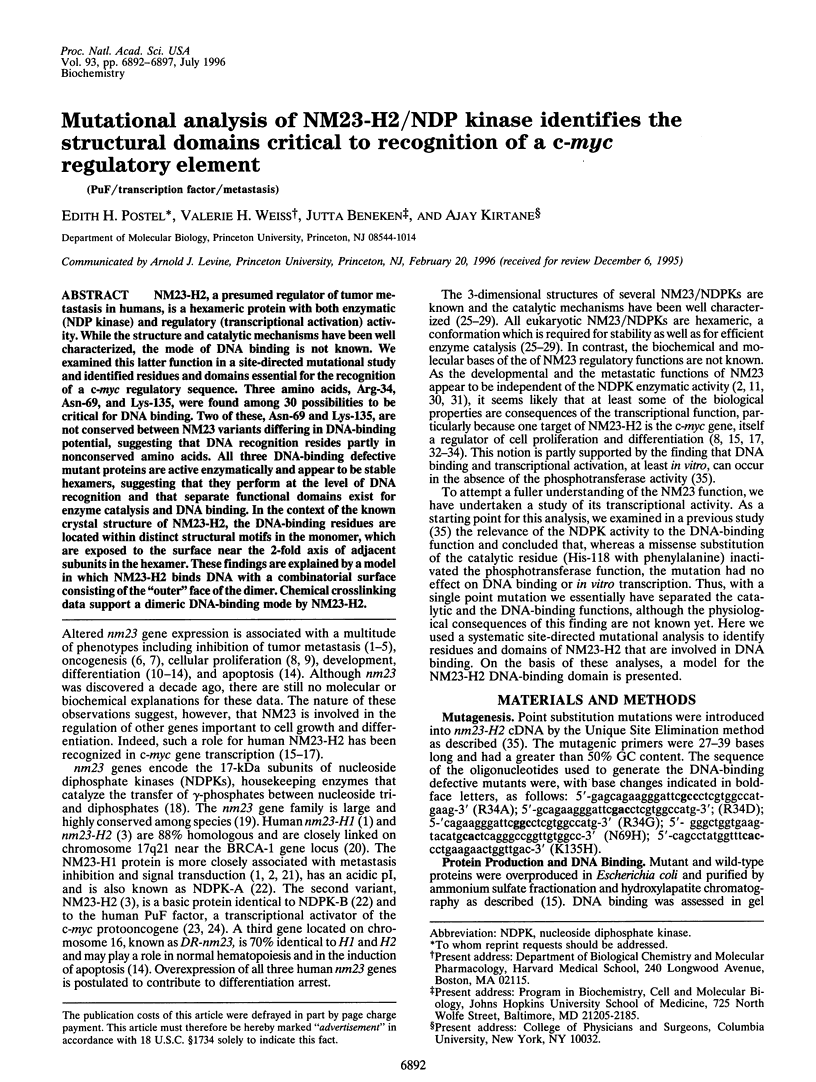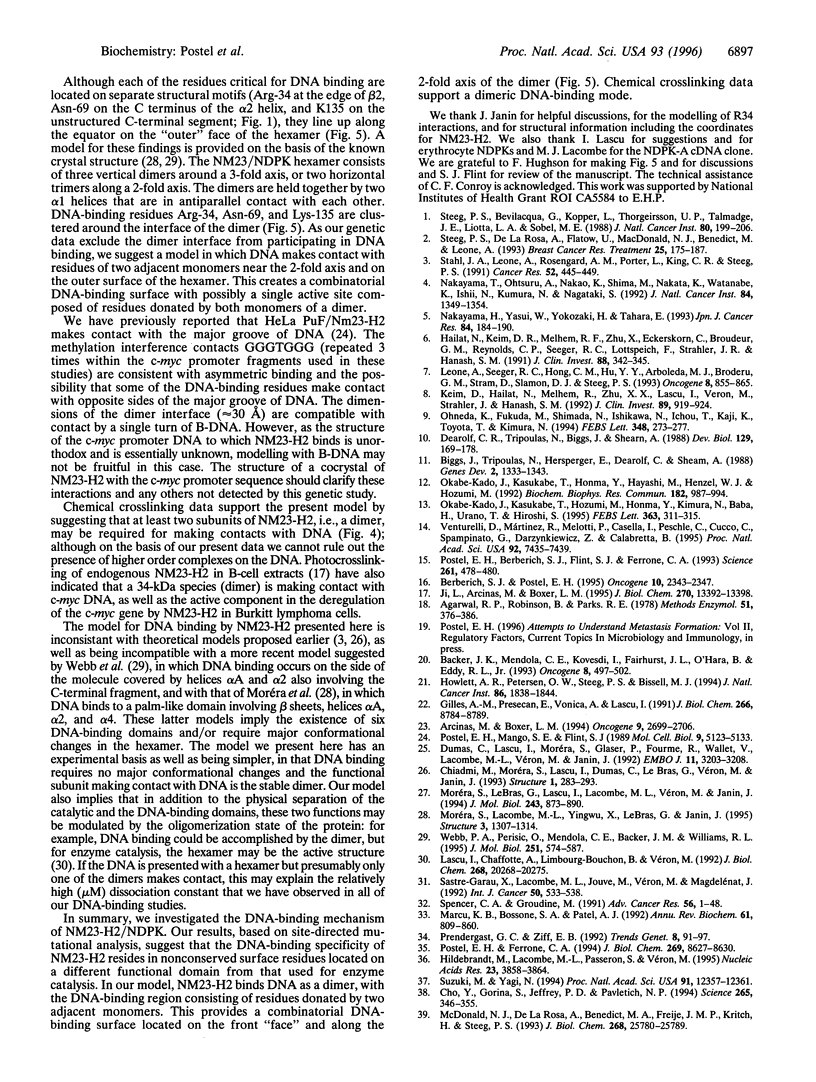Abstract
NM23-H2, a presumed regulator of tumor metastasis in humans, is a hexameric protein with both enzymatic (NDP kinase) and regulatory (transcriptional activation) activity. While the structure and catalytic mechanisms have been well characterized, the mode of DNA binding is not known. We examined this latter function in a site-directed mutational study and identified residues and domains essential for the recognition of a c-myc regulatory sequence. Three amino acids, Arg-34, Asn-69, and Lys-135, were found among 30 possibilities to be critical for DNA binding. Two of these, Asn-69 and Lys-135, are not conserved between NM23 variants differing in DNA-binding potential, suggesting that DNA recognition resides partly in nonconserved amino acids. All three DNA-binding defective mutant proteins are active enzymatically and appear to be stable hexamers, suggesting that they perform at the level of DNA recognition and that separate functional domains exist for enzyme catalysis and DNA binding. In the context of the known crystal structure of NM23-H2, the DNA-binding residues are located within distinct structural motifs in the monomer, which are exposed to the surface near the 2-fold axis of adjacent subunits in the hexamer. These findings are explained by a model in which NM23-H2 binds DNA with a combinatorial surface consisting of the "outer" face of the dimer. Chemical crosslinking data support a dimeric DNA-binding mode by NM23-H2.
Full text
PDF





Images in this article
Selected References
These references are in PubMed. This may not be the complete list of references from this article.
- Agarwal R. P., Robison B., Parks R. E., Jr Nucleoside diphosphokinase from human erythrocytes. Methods Enzymol. 1978;51:376–386. doi: 10.1016/s0076-6879(78)51051-3. [DOI] [PubMed] [Google Scholar]
- Arcinas M., Boxer L. M. Differential protein binding to the c-myc promoter during differentiation of hematopoietic cell lines. Oncogene. 1994 Sep;9(9):2699–2706. [PubMed] [Google Scholar]
- Backer J. M., Mendola C. E., Kovesdi I., Fairhurst J. L., O'Hara B., Eddy R. L., Jr, Shows T. B., Mathew S., Murty V. V., Chaganti R. S. Chromosomal localization and nucleoside diphosphate kinase activity of human metastasis-suppressor genes NM23-1 and NM23-2. Oncogene. 1993 Feb;8(2):497–502. [PubMed] [Google Scholar]
- Berberich S. J., Postel E. H. PuF/NM23-H2/NDPK-B transactivates a human c-myc promoter-CAT gene via a functional nuclease hypersensitive element. Oncogene. 1995 Jun 15;10(12):2343–2347. [PubMed] [Google Scholar]
- Biggs J., Tripoulas N., Hersperger E., Dearolf C., Shearn A. Analysis of the lethal interaction between the prune and Killer of prune mutations of Drosophila. Genes Dev. 1988 Oct;2(10):1333–1343. doi: 10.1101/gad.2.10.1333. [DOI] [PubMed] [Google Scholar]
- Chiadmi M., Moréra S., Lascu I., Dumas C., Le Bras G., Véron M., Janin J. Crystal structure of the Awd nucleotide diphosphate kinase from Drosophila. Structure. 1993 Dec 15;1(4):283–293. doi: 10.1016/0969-2126(93)90016-a. [DOI] [PubMed] [Google Scholar]
- Cho Y., Gorina S., Jeffrey P. D., Pavletich N. P. Crystal structure of a p53 tumor suppressor-DNA complex: understanding tumorigenic mutations. Science. 1994 Jul 15;265(5170):346–355. doi: 10.1126/science.8023157. [DOI] [PubMed] [Google Scholar]
- Dearolf C. R., Tripoulas N., Biggs J., Shearn A. Molecular consequences of awdb3, a cell-autonomous lethal mutation of Drosophila induced by hybrid dysgenesis. Dev Biol. 1988 Sep;129(1):169–178. doi: 10.1016/0012-1606(88)90171-6. [DOI] [PubMed] [Google Scholar]
- Dumas C., Lascu I., Moréra S., Glaser P., Fourme R., Wallet V., Lacombe M. L., Véron M., Janin J. X-ray structure of nucleoside diphosphate kinase. EMBO J. 1992 Sep;11(9):3203–3208. doi: 10.1002/j.1460-2075.1992.tb05397.x. [DOI] [PMC free article] [PubMed] [Google Scholar]
- Gilles A. M., Presecan E., Vonica A., Lascu I. Nucleoside diphosphate kinase from human erythrocytes. Structural characterization of the two polypeptide chains responsible for heterogeneity of the hexameric enzyme. J Biol Chem. 1991 May 15;266(14):8784–8789. [PubMed] [Google Scholar]
- Hailat N., Keim D. R., Melhem R. F., Zhu X. X., Eckerskorn C., Brodeur G. M., Reynolds C. P., Seeger R. C., Lottspeich F., Strahler J. R. High levels of p19/nm23 protein in neuroblastoma are associated with advanced stage disease and with N-myc gene amplification. J Clin Invest. 1991 Jul;88(1):341–345. doi: 10.1172/JCI115299. [DOI] [PMC free article] [PubMed] [Google Scholar]
- Hildebrandt M., Lacombe M. L., Mesnildrey S., Véron M. A human NDP-kinase B specifically binds single-stranded poly-pyrimidine sequences. Nucleic Acids Res. 1995 Oct 11;23(19):3858–3864. doi: 10.1093/nar/23.19.3858. [DOI] [PMC free article] [PubMed] [Google Scholar]
- Howlett A. R., Petersen O. W., Steeg P. S., Bissell M. J. A novel function for the nm23-H1 gene: overexpression in human breast carcinoma cells leads to the formation of basement membrane and growth arrest. J Natl Cancer Inst. 1994 Dec 21;86(24):1838–1844. doi: 10.1093/jnci/86.24.1838. [DOI] [PMC free article] [PubMed] [Google Scholar]
- Ji L., Arcinas M., Boxer L. M. The transcription factor, Nm23H2, binds to and activates the translocated c-myc allele in Burkitt's lymphoma. J Biol Chem. 1995 Jun 2;270(22):13392–13398. doi: 10.1074/jbc.270.22.13392. [DOI] [PubMed] [Google Scholar]
- Keim D., Hailat N., Melhem R., Zhu X. X., Lascu I., Veron M., Strahler J., Hanash S. M. Proliferation-related expression of p19/nm23 nucleoside diphosphate kinase. J Clin Invest. 1992 Mar;89(3):919–924. doi: 10.1172/JCI115672. [DOI] [PMC free article] [PubMed] [Google Scholar]
- Lascu I., Deville-Bonne D., Glaser P., Véron M. Equilibrium dissociation and unfolding of nucleoside diphosphate kinase from Dictyostelium discoideum. Role of proline 100 in the stability of the hexameric enzyme. J Biol Chem. 1993 Sep 25;268(27):20268–20275. [PubMed] [Google Scholar]
- Leone A., Seeger R. C., Hong C. M., Hu Y. Y., Arboleda M. J., Brodeur G. M., Stram D., Slamon D. J., Steeg P. S. Evidence for nm23 RNA overexpression, DNA amplification and mutation in aggressive childhood neuroblastomas. Oncogene. 1993 Apr;8(4):855–865. [PubMed] [Google Scholar]
- MacDonald N. J., De la Rosa A., Benedict M. A., Freije J. M., Krutsch H., Steeg P. S. A serine phosphorylation of Nm23, and not its nucleoside diphosphate kinase activity, correlates with suppression of tumor metastatic potential. J Biol Chem. 1993 Dec 5;268(34):25780–25789. [PubMed] [Google Scholar]
- Marcu K. B., Bossone S. A., Patel A. J. myc function and regulation. Annu Rev Biochem. 1992;61:809–860. doi: 10.1146/annurev.bi.61.070192.004113. [DOI] [PubMed] [Google Scholar]
- Moréra S., Lacombe M. L., Xu Y., LeBras G., Janin J. X-ray structure of human nucleoside diphosphate kinase B complexed with GDP at 2 A resolution. Structure. 1995 Dec 15;3(12):1307–1314. doi: 10.1016/s0969-2126(01)00268-4. [DOI] [PubMed] [Google Scholar]
- Moréra S., LeBras G., Lascu I., Lacombe M. L., Véron M., Janin J. Refined X-ray structure of Dictyostelium discoideum nucleoside diphosphate kinase at 1.8 A resolution. J Mol Biol. 1994 Nov 11;243(5):873–890. doi: 10.1006/jmbi.1994.1689. [DOI] [PubMed] [Google Scholar]
- Nakayama H., Yasui W., Yokozaki H., Tahara E. Reduced expression of nm23 is associated with metastasis of human gastric carcinomas. Jpn J Cancer Res. 1993 Feb;84(2):184–190. doi: 10.1111/j.1349-7006.1993.tb02853.x. [DOI] [PMC free article] [PubMed] [Google Scholar]
- Nakayama T., Ohtsuru A., Nakao K., Shima M., Nakata K., Watanabe K., Ishii N., Kimura N., Nagataki S. Expression in human hepatocellular carcinoma of nucleoside diphosphate kinase, a homologue of the nm23 gene product. J Natl Cancer Inst. 1992 Sep 2;84(17):1349–1354. doi: 10.1093/jnci/84.17.1349. [DOI] [PubMed] [Google Scholar]
- Ohneda K., Fukuda M., Shimada N., Ishikawa N., Ichou T., Kaji K., Toyota T., Kimura N. Increased expression of nucleoside diphosphate kinases/nm23 in human diploid fibroblasts transformed by SV40 large T antigen or 60Co irradiation. FEBS Lett. 1994 Jul 18;348(3):273–277. doi: 10.1016/0014-5793(94)00623-7. [DOI] [PubMed] [Google Scholar]
- Okabe-Kado J., Kasukabe T., Honma Y., Hayashi M., Henzel W. J., Hozumi M. Identity of a differentiation inhibiting factor for mouse myeloid leukemia cells with NM23/nucleoside diphosphate kinase. Biochem Biophys Res Commun. 1992 Feb 14;182(3):987–994. doi: 10.1016/0006-291x(92)91829-f. [DOI] [PubMed] [Google Scholar]
- Okabe-Kado J., Kasukabe T., Hozumi M., Honma Y., Kimura N., Baba H., Urano T., Shiku H. A new function of Nm23/NDP kinase as a differentiation inhibitory factor, which does not require it's kinase activity. FEBS Lett. 1995 Apr 24;363(3):311–315. doi: 10.1016/0014-5793(95)00338-a. [DOI] [PubMed] [Google Scholar]
- Postel E. H., Berberich S. J., Flint S. J., Ferrone C. A. Human c-myc transcription factor PuF identified as nm23-H2 nucleoside diphosphate kinase, a candidate suppressor of tumor metastasis. Science. 1993 Jul 23;261(5120):478–480. doi: 10.1126/science.8392752. [DOI] [PubMed] [Google Scholar]
- Postel E. H., Ferrone C. A. Nucleoside diphosphate kinase enzyme activity of NM23-H2/PuF is not required for its DNA binding and in vitro transcriptional functions. J Biol Chem. 1994 Mar 25;269(12):8627–8630. [PubMed] [Google Scholar]
- Postel E. H., Mango S. E., Flint S. J. A nuclease-hypersensitive element of the human c-myc promoter interacts with a transcription initiation factor. Mol Cell Biol. 1989 Nov;9(11):5123–5133. doi: 10.1128/mcb.9.11.5123. [DOI] [PMC free article] [PubMed] [Google Scholar]
- Prendergast G. C., Ziff E. B. A new bind for Myc. Trends Genet. 1992 Mar;8(3):91–96. doi: 10.1016/0168-9525(92)90196-b. [DOI] [PubMed] [Google Scholar]
- Sastre-Garau X., Lacombe M. L., Jouve M., Véron M., Magdelénat H. Nucleoside diphosphate kinase/NM23 expression in breast cancer: lack of correlation with lymph-node metastasis. Int J Cancer. 1992 Feb 20;50(4):533–538. doi: 10.1002/ijc.2910500406. [DOI] [PubMed] [Google Scholar]
- Spencer C. A., Groudine M. Control of c-myc regulation in normal and neoplastic cells. Adv Cancer Res. 1991;56:1–48. doi: 10.1016/s0065-230x(08)60476-5. [DOI] [PubMed] [Google Scholar]
- Stahl J. A., Leone A., Rosengard A. M., Porter L., King C. R., Steeg P. S. Identification of a second human nm23 gene, nm23-H2. Cancer Res. 1991 Jan 1;51(1):445–449. [PubMed] [Google Scholar]
- Steeg P. S., de la Rosa A., Flatow U., MacDonald N. J., Benedict M., Leone A. Nm23 and breast cancer metastasis. Breast Cancer Res Treat. 1993;25(2):175–187. doi: 10.1007/BF00662142. [DOI] [PubMed] [Google Scholar]
- Suzuki M., Yagi N. DNA recognition code of transcription factors in the helix-turn-helix, probe helix, hormone receptor, and zinc finger families. Proc Natl Acad Sci U S A. 1994 Dec 20;91(26):12357–12361. doi: 10.1073/pnas.91.26.12357. [DOI] [PMC free article] [PubMed] [Google Scholar]
- Venturelli D., Martinez R., Melotti P., Casella I., Peschle C., Cucco C., Spampinato G., Darzynkiewicz Z., Calabretta B. Overexpression of DR-nm23, a protein encoded by a member of the nm23 gene family, inhibits granulocyte differentiation and induces apoptosis in 32Dc13 myeloid cells. Proc Natl Acad Sci U S A. 1995 Aug 1;92(16):7435–7439. doi: 10.1073/pnas.92.16.7435. [DOI] [PMC free article] [PubMed] [Google Scholar]
- Webb P. A., Perisic O., Mendola C. E., Backer J. M., Williams R. L. The crystal structure of a human nucleoside diphosphate kinase, NM23-H2. J Mol Biol. 1995 Aug 25;251(4):574–587. doi: 10.1006/jmbi.1995.0457. [DOI] [PubMed] [Google Scholar]






